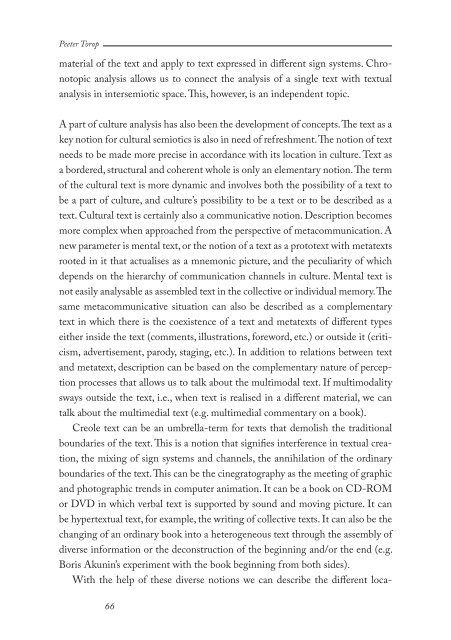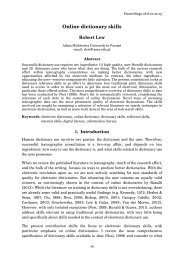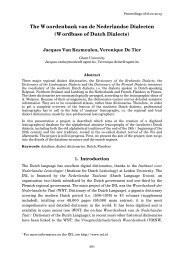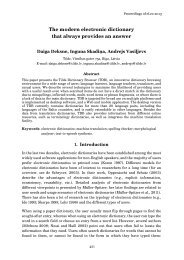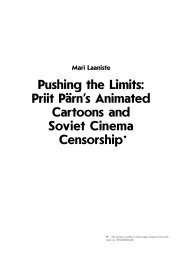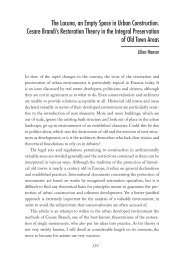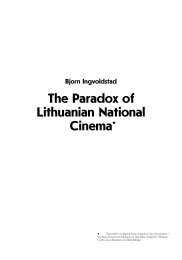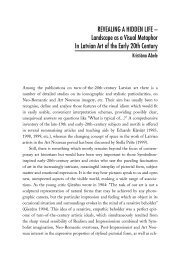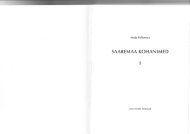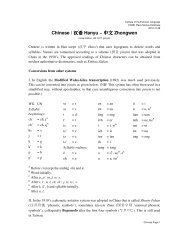LOCATIONS in INTERSEMIOTIC SPACE*
LOCATIONS in INTERSEMIOTIC SPACE*
LOCATIONS in INTERSEMIOTIC SPACE*
Create successful ePaper yourself
Turn your PDF publications into a flip-book with our unique Google optimized e-Paper software.
Peeter Torop<br />
material of the text and apply to text expressed <strong>in</strong> different sign systems. Chro-<br />
notopic analysis allows us to connect the analysis of a s<strong>in</strong>gle text with textual<br />
analysis <strong>in</strong> <strong>in</strong>tersemiotic space. is, however, is an <strong>in</strong>dependent topic.<br />
A part of culture analysis has also been the development of concepts. e text as a<br />
key notion for cultural semiotics is also <strong>in</strong> need of refreshment. e notion of text<br />
needs to be made more precise <strong>in</strong> accordance with its location <strong>in</strong> culture. Text as<br />
a bordered, structural and coherent whole is only an elementary notion. e term<br />
of the cultural text is more dynamic and <strong>in</strong>volves both the possibility of a text to<br />
be a part of culture, and culture’s possibility to be a text or to be described as a<br />
text. Cultural text is certa<strong>in</strong>ly also a communicative notion. Description becomes<br />
more complex when approached from the perspective of metacommunication. A<br />
new parameter is mental text, or the notion of a text as a prototext with metatexts<br />
rooted <strong>in</strong> it that actualises as a mnemonic picture, and the peculiarity of which<br />
depends on the hierarchy of communication channels <strong>in</strong> culture. Mental text is<br />
not easily analysable as assembled text <strong>in</strong> the collective or <strong>in</strong>dividual memory. e<br />
same metacommunicative situation can also be described as a complementary<br />
text <strong>in</strong> which there is the coexistence of a text and metatexts of different types<br />
either <strong>in</strong>side the text (comments, illustrations, foreword, etc.) or outside it (criti-<br />
cism, advertisement, parody, stag<strong>in</strong>g, etc.). In addition to relations between text<br />
and metatext, description can be based on the complementary nature of percep-<br />
tion processes that allows us to talk about the multimodal text. If multimodality<br />
sways outside the text, i.e., when text is realised <strong>in</strong> a different material, we can<br />
talk about the multimedial text (e.g. multimedial commentary on a book).<br />
Creole text can be an umbrella-term for texts that demolish the traditional<br />
boundaries of the text. is is a notion that signifies <strong>in</strong>terference <strong>in</strong> textual crea-<br />
tion, the mix<strong>in</strong>g of sign systems and channels, the annihilation of the ord<strong>in</strong>ary<br />
boundaries of the text. is can be the c<strong>in</strong>egratography as the meet<strong>in</strong>g of graphic<br />
and photographic trends <strong>in</strong> computer animation. It can be a book on CD-ROM<br />
or DVD <strong>in</strong> which verbal text is supported by sound and mov<strong>in</strong>g picture. It can<br />
be hypertextual text, for example, the writ<strong>in</strong>g of collective texts. It can also be the<br />
chang<strong>in</strong>g of an ord<strong>in</strong>ary book <strong>in</strong>to a heterogeneous text through the assembly of<br />
diverse <strong>in</strong>formation or the deconstruction of the beg<strong>in</strong>n<strong>in</strong>g and/or the end (e.g.<br />
Boris Akun<strong>in</strong>’s experiment with the book beg<strong>in</strong>n<strong>in</strong>g from both sides).<br />
With the help of these diverse notions we can describe the different loca-<br />
66


